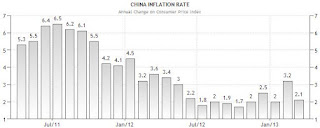CPI, by definition, is generally used to reflect the trend or degree of changes in prices of consumer goods and services purchased by urban and also rural households in PRC (People's Republic of China) during a given period. It allows basic observation or analysis of the impact for changes in prices level of retailed goods and services on major living expenses of urban and rural residents.
China CPI (Consumer Price Index) is published by the National Bureau of Statistics (NBS) in PRC with its own formula. The weights for China CPI calculation are determined in accordance with the composition of consumption expenditures for more than 100K urban and rural households. As the weights for calculation of China CPI formula are determined by the composition of consumption expenditures for urban and rural households, China CPI formula is also known as a combination of Consumer Price Indices For Urban Household and Consumer Price Indices of Rural Household. China CPI formula contains a number of weighted categories including food, clothing, household facilities, healthcare, transportation, communication, recreation, education, residence, culture, tobacco, liquor and articles etc.
Please note that China already applied a new Consumer Price Index (CPI) formula with re-adjusted weights for various categories since January 2011. According to our data, however, results compiled by this new CPI formula deviate just no more than 0.2% from the old one.
Along the practice of previous years, our independent PRC inflation expert team members has calculated the 2013 fair value of each weighted category mentioned above and then put all fair values into the CPI formula. As per our calculations, the PRC annual CPI (Consumer Price Index) will raise by +3.8% YoY in 2013. This calculated inflation target suggests that we anticipate the inflation pressure will rebound in 2013. In 2012 (full year), PRC inflation (CPI) increased only by +2.6% YoY, lower than our previous target level of +4.5%.
Why our team expects +3.8% inflation (CPI) hike for 2013? Here are our fundamental 2013 assumptions:
(a) China domestic inflation pressure should be stable for 2013. Food price rises are expected to become moderate in 2013 as well. The only unknown factor should be the recent H7N9 bird flu started around Shanghai region. This factor is still highly unpredictable for PRC inflation because no one actually knows how serious this H7N9 bird flu will be and how it will affect Chinese economy as a whole.
(b) Quantitative easing policies outside China will surely increase inflation pressure domestically in PRC. In the U.S., FOMC (Federal Reserve Market Committee) already announced on December 12, 2012 to execute QE4 (4th round of quantitative easing) to buy additional amount of treasury bonds by USD$45 billion every month. Source: Quantitative Easing Policy.
(c) For other developed economies like Japan, quantitative easing policy can be even more aggressive. Japan central bank already announced in April 2013 to run an unlimited QE program in order to push its domestic inflation level up to +2% YoY. It is expected that Japanese Yen (JPY) will continue to drop on higher bond yield expectation. Capitals will therefore escape from Japan, and demands for carry-trades will also become strong. This kind of hot money from Japan will flow out to other developing economies including China, Brazil, or India and then trigger high inflation pressure there.
(d) In Europe, economy has been no better and is still struggling by European sovereign-debt related crisis. Recent banking sector crisis in Cyprus also indicates that banking system in some Eurozone countries can be highly unreliable. We believe that Eurozone will continue to reply on its own innovative QE policy such as LTRO (Longer-term Refinancing Operation) from ECB (European Central Bank) to save the banking sector in Europe region. This factor is still unpredictable for China because no one knows when will these massive LTRO money will flow back into the real economy and actually induce inflation expectation outside Europe.
(e) In Asia, 2013 must be an unstable year as North Korea has started to fight against the U.S., South Korea and/or Japan alliance by firing missiles or conducting nuclear tests. If really there is a war at eastern-north Asia region (especially nuclear war), then it will of course severely affect inflation pressure for China.

Current China Inflation (CPI) Chart
The +3.8% YoY inflation estimation is only our initial release of PRC Consumer Price Index (CPI) target value for 2013, our team may consider to downgrade/upgrade it in later stage if there is any major change in the related 2013 economic environment.
Complementary Article(s) For China Economic Targets:
Full Table Summary For All Our Announced China Economic Targets including Inflation (CPI)
0 Comments:
Post a Comment